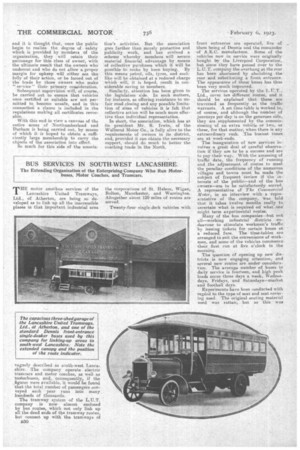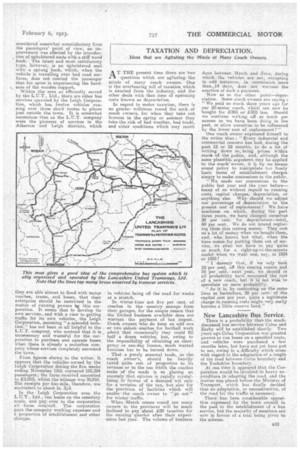BUS SERVICES IN SOUTH-WEST LANCASHIRE.
Page 14

Page 15

If you've noticed an error in this article please click here to report it so we can fix it.
The Extending Organization of the Enterprising Company Who Run Motorbuses, Motor Coaches, and Tramcars.
THE motor omnibus services of the Lancashire UnitedTramways, Ltd., of Atherton, are being so developed as to link up all the inaccessible places in that important industrial area vaguely described as south-west Lancashire. The company operate electric tramcars and motor coaches, as well as motorbuses, and,. consequently-, if the figurer,. were available, it would be found that the total number of passengers conveyed each year runs into many hundreds of thousands.
The tramway system of the LILT. company is now almost enclosed by bus routes, which not only link up all the dead ends of the tramway routes, but connect up with the tramways of B30 the corporations of St. Helens, Wigan, Bolton, Manchester, and Warrington. Altogether about 120 miles of routes are served.
Twenty-four single-deck vehicles with
front entrances are operated, five of them being of Dennis and the remainder of A.E.C. manufacture. Some of the vehicles now in serviee were originally bought 13.3, the Liverpool Corporation, but since they have passed over to the L. U.T. company the overhang at the rear has been shortened by abolishing the rear and substituting a front entrance. The appearance of these buses has thus been very much improved.
• The services operated by the L.U.T., Ltd., cover ten different routes, and it should be explained that these are traversed as frequently as the traffic warrants. A set time-table is worked to, of course, and although the number of journeys per day is on the generous side, they are supplemented by the commis-. sioning of an extra vehicle or two, or three, for that matter, when there is any extraordinary rush. The busiest times. are at week-ends.
The inauguration of new services involves a great deal of careful observation if they are to be a success and are to pay their way. With the amassing of traffic data the frequency of running and the adjustment of routes to meet the peculiar conditions of the numerous villages and towns must he made the subject of frequent -review if the interests of the public—and of the bus owners—are to be satisfactorily served. A representative of The Commercial Motor, in an interview with a .reppesentative of the company, Was told that it takes twelve months really to ascertain what is required ori what One might term experimental routes.
Many of the bus conapanies--but not all—working industrial districts endeavour to stimulate workmen's traffic by issuing tickets for certain buses at a reduced fare. The time-tables are arranged to suit the convenience of workmen, and some of the vehicles commence their first run at fi.rie o'clock in the morning. The question of opening up new districts is now engaging attention, and several new routes are under consideration. The average number of buses in daily service is fourteen, and high peak loads occur three days a week, Wednesdays, Fridays, and Saturdays—market and football days.
Experiments have been conducted with rega'rd to the type of seat and seat covering used. The original seating material used was rattan, but as this was
considered somewhat unsatisfactory from the passengers' point of view, an improvement was effected by the introduction of upholstered seats with a stiff wood back, The latest and most satisfactory type, however, is an upholstered seat with a sprung back, which, when the vehicle is travelling over bad road surfaces, does not remind the passenger that his spine is experiencing the hardness of the wooden support.
Within the area so efficiently served by the LILT., Ltd., there are other bus services operated by the Leigh Corporation, which has twelve vehicles running over three short routes to places just outside the town. It is somewhat anomalous that as the L.U.T. company were the pioneers of services in the Atherton • and Leigh districts, which
they are able almost to flood with motor coaches, trams, and buses, -that their enterprise should be restricted in the matter of running powers 1N,r this corporation. It seems that to develop its own services, and with a view to getting traffic for its own vehicles, the Leigh Corporation, assuming 'a splendid isolation," has not been at all helpful to the LILT. company, who contend that, it is unnecessary and wasteful for the corporation to purchase and operate buses when there is already a meterbus company whose services completely surround the town.
From figures shown to the writer, it appears that the vehicles owned by the Leigh Corporation during the five weeks ending November 15th conveyed 182,394 passengers ; the fares received amounted to £2,018, whilst the Mileage was 30,910. The receipts per bus-mile, therefore, are
equivalent to about Is. 30. • In the Leigh Corporation area the -Ltd., run buses On the cemetery route, and pay over to the corporation all fares received._ The corporation pays the company working expenses and a proportion of establishment and other charges.




























